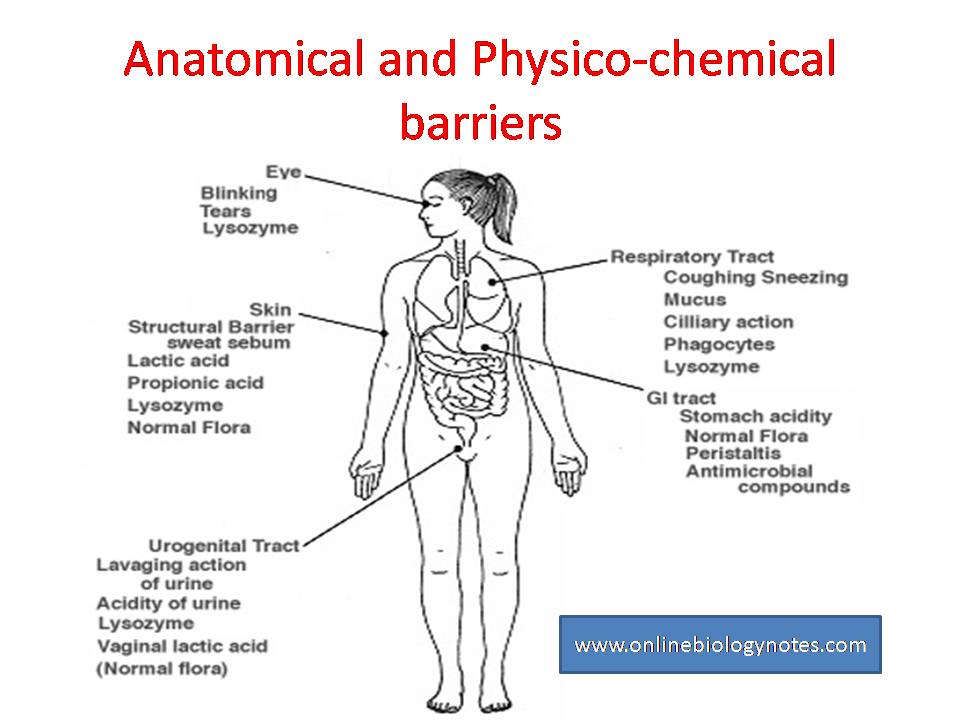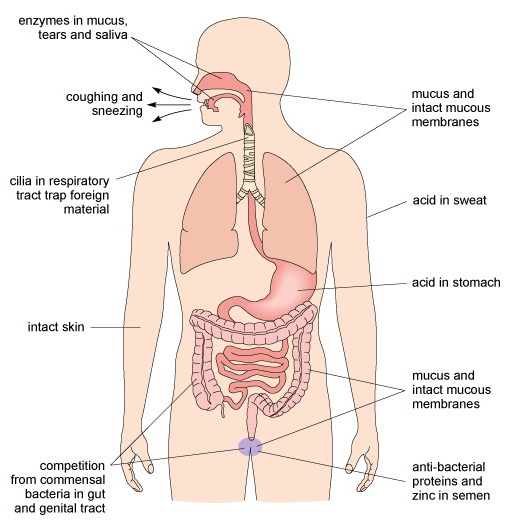Examples of Chemical Barriers in the Immune System
The immune system protects organisms from infection with layered defenses of increasing specificity. Pathogens are killed or inactivated on the skin by desiccation drying out and by the skins acidity.

Anatomical And Physico Chemical Barriers Of Immune System Online Biology Notes
Sweat mucus tears saliva and breastmilk all contain antimicrobial substances such as the enzyme lysozyme that kill pathogens especially bacteria.

. The details of how these. Examples include the bodys complement system and substances called interferon and interleukin-1 which causes fever. The second line of defense is an internal defense system designed to counter pathogenic threats that bypass the physical and chemical barriers of the body.
Physical barriers provide innate protection such as the tough overlapping cells of the skin and chemical barriers and enzymes such as lysozyme in snot and tears and the acid in the stomach also kill many bacteria. Many inflammatory mediators such as histamine are vasodilators that. It is hydrochloric acid and is strong enough to kill any pathogens that have been caught in mucus in.
Additional barriers include the mucous membranes tears ear wax mucus and stomach acid. The immune system comprises both innate and adaptive immune responses. A distinct lymphocyte -derived molecule has been discovered in primitive jawless vertebrates such as the lamprey and hagfish.
Second line of defence The second line of defence is an innate immunity meaning that we are born with this of defence by nature. Most simply physical barriers prevent pathogens such as bacteria and viruses from entering the body. In addition beneficial microorganisms that coexist on the skin compete with.
Chemical barriers destroy pathogens on the outer body surface at body openings and on inner body linings. If the pathogens infection is severe enough to cause a fever to occur it starts the bodys last line of defense agains these invaders. If a pathogen breaches these barriers the innate immune system provides an immediate but non-specific response.
Examples of barriers include skin mechanical which physically prevent pathogens from coming in and mucus containing enzymes chemical which destroys pathogens that come into contact with the enzymes. Physical and Chemical Barriers. Chemical barriers also protect against infection by pathogens.
The released contents of injured cells stimulate the release of mast cell granules and their potent inflammatory mediators such as. Layered defense in immunity. Innate immunity also comes in a protein chemical form called innate humoral immunity.
Up to 24 cash back The Immune System. To do this the immune system must distinguish between self. Acidic environments such as sweat salt fatty acids skin oils and lysozymes tears and saliva.
The innate immune system serves as a first responder to pathogenic threats that bypass natural physical and chemical barriers of the body. These outward-facing surfaces actually encourage the presence of non. The skin and mucous membranes make this close approach difficult.
In addition the immune system includes. Chemical Barriers Lysozyme an enzyme produced in tears perspiration and saliva can break down cell walls and thus acts as an antibiotic kills bacteria Gastric juice in the stomach destroys bacteria and most toxins because the gastric juice is highly acidic pH 2-3. Many of the classical molecules of the adaptive immune system for example immunoglobulins and T-cell receptors exist only in jawed vertebrates.
There are four important parts to the inflammatory response. Layered defense in immunity. Innate immunity occurs naturally because of genetic factors or physiology.
Physical Barriers The immune system consists of a network of white blood cells antibodies and other substances that. The immune system relies on white blood cells and antibodies to identify and eliminate organisms that manage to pass through the physical barriers. The first line of defense consists of the bodys mechanical chemical and biological barriers.
The immune system protects you from dying from infection with layered defenses of increasing specificity. Also the normal flow of urine washes out microorganisms that have entered the urinary tract. 9 rows The immune system refers to a collection of cells chemicals and processes that function to.
Using a combination of cellular and molecular attacks the innate immune system identifies the nature of a pathogen and responds with inflammation phagocytosis cytokine release destruction by NK cells. Sweat mucus tears and saliva all contain enzymes that kill pathogens. Before any immune factors are triggered the skin functions as a continuous impassable barrier to potentially infectious pathogens.
Stomach acid is a chemical barrier against infection. Read more and horses Physical Barriers The immune system consists of a network of white blood cells antibodies and other substances that fight off infections and reject foreign proteins. The innate immune system provides this kind of nonspecific protection through a number of defense mechanisms which include physical barriers such as the skin chemical barriers such as antimicrobial proteins that harm or destroy invaders and cells that attack foreign cells and body cells harbouring infectious agents.
If an antigen gets past these barriers it is attacked and destroyed by other parts of the immune system. They destroy pathogens on the outer body surface at body openings and on inner body linings. It is not induced by infection or vaccination but works to reduce the workload for the adaptive immune responseBoth the innate and adaptive levels of the immune response involve secreted proteins receptor.
The Immune Systems cells are able to differentiate between different pathogens and target the specific type of pathogen infection. Broadly speaking there are two main chemical barriers to infection. Most simply physical barriers prevent pathogens such as bacteria and viruses from entering the body.
To do this the immune system must distinguish between self. The innate immune system consists first of physical and chemical barriers to infection including the skin and mucous membranes and their secretions ciliated surfaces and body hairs. The Immune Response controlled by the Immune System.
Urine is too acidic for many pathogens and semen contains zinc which most pathogens cannot tolerate. Up to 24 cash back Chemical barriers include. Physical Barriers The primary role of the immune system is to defend the body against foreign invaders or abnormal cells that invade or attack it.
If a pathogen breaches these barriers the innate immune system provides an immediate but non-specific response.

Infection And Immunity Openlearn Open University

Immune System Biology Ppt Video Online Download

What Is First Line Of Defence In Immune System Physical Chemical Biological Barriers Involved Youtube
Comments
Post a Comment